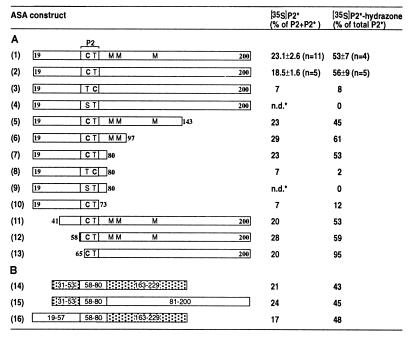Figure 4.
Modification of Cys-69 in ASA depends on adjacent sequence information. In vitro modification efficiencies for ASA constructs 1–16 are expressed as percentage of [35S]P2* of the sum of labeled P2 plus P2*, as determined after HPLC of tryptic peptides (see Fig. 2). In addition, the fraction of [35S]P2* that was converted into the corresponding DNP-hydrazone (see Fig. 3) is given. The SD calculated from independent experiments is given only for constructs 1 and 2 and was similar for all other constructs. (A) The constructs were synthesized in vitro in the presence of microsomes (Fig. 2A) as fusions of preprolactin signal peptide and ASA fragments with different C and N termini, which are given by the numbers. In peptide 2 amino acid residues 69 and 70 are shown. Where present, the methionines in positions 85, 87, and 120 are indicated. In other constructs they were mutated (see Fig. 2C). The methionine introduced in position 59 (constructs 1–12) or 64 (construct 13) is not shown. C-terminal truncations were generated by introducing stop-codons into the cDNA. The N terminus was shortened by fusing the signal peptide encoding sequence to various codons of ASA cDNA. In constructs 3 and 8 the sequence of Cys-69 and Thr-70 was inverted and in constructs 4 and 9 Cys-69 was replaced by serine. (B) Chimeras were analyzed in which residues 19–57 and/or residues 81–200 of ASA construct 2 (A) were replaced by residues 31–53 and/or 163–229 of preprolactin, as indicated. In the scheme the sequences derived from preprolactin are stippled. All constructs retain the tryptic peptide 2 of ASA (residues 59–73), which contains the only methionine (Met-59) present in the chimeric polypeptides. n.d.*: After HPLC, the nonmodified Ser-69 containing form of [35S]P2 eluted partially overlapping with the modified form of unlabeled peptide 2, P2* (see Fig. 2D). A calculation of [35S]P2* was therefore not possible. The labeled material, assayed fraction by fraction, did not react with DNP-hydrazine.

